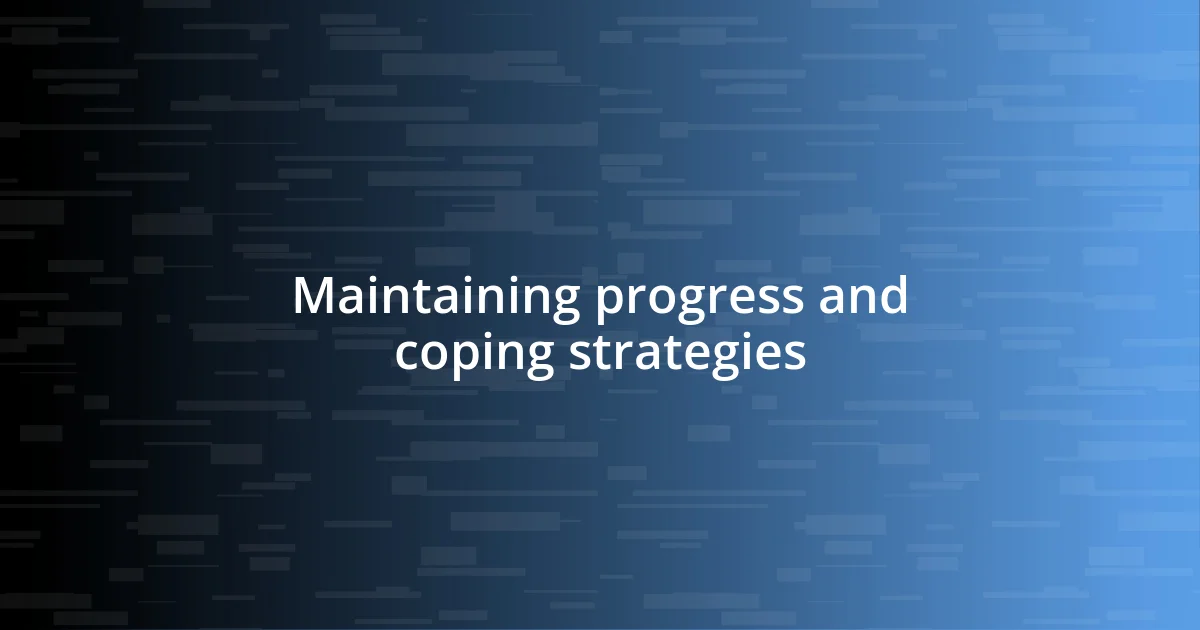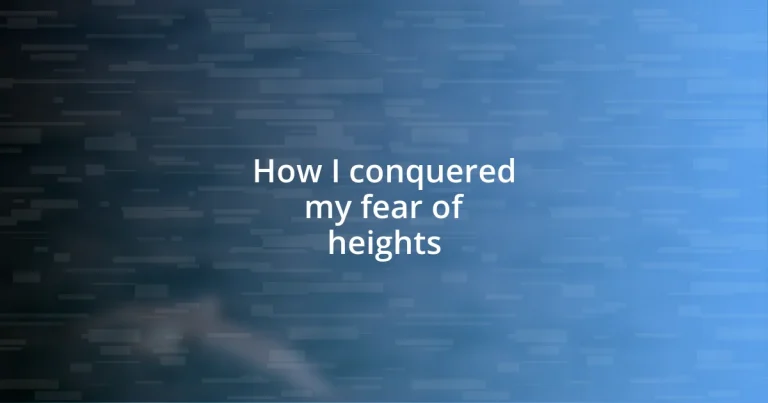Key takeaways:
- Identifying personal triggers for acrophobia helps in recognizing and managing fears effectively.
- Gradual exposure and breathing techniques are essential strategies for overcoming the fear of heights.
- Celebrating small victories and seeking professional help can significantly enhance confidence and progress in dealing with fears.

Understanding the fear of heights
Understanding the fear of heights, also known as acrophobia, is quite fascinating. For me, it stemmed from a childhood incident during a family trip when I slipped while climbing a tree. The memory still gives me chills; it’s interesting to think how a single moment can shape an entire perception of safety and risk.
I’ve often wondered why so many people share this fear. Is it evolutionary? Perhaps it’s rooted in our instinct to avoid potentially dangerous situations. I remember attending a friend’s wedding on a rooftop terrace. The beautiful view quickly turned overwhelming as I looked down, and I could feel that primal instinct kicking in, urging me to step back from the edge.
When grappling with this fear, it’s important to recognize that it’s not just in our heads. It grips our bodies too, producing physical sensations like racing heartbeats and sweaty palms. Those feelings were all too real for me during my first attempt at indoor rock climbing; I almost backed out until I realized that confronting my feelings head-on was the only way to untangle the knots of fear within.

Identifying personal triggers
Identifying personal triggers for my fear of heights was a transformative step in my journey. I found myself reflecting on specific situations that evoked panic. For instance, I realized that not just the height itself, but also the stability of the ground beneath my feet played a crucial role. Once, while standing on the balcony of a high-rise hotel, I could feel my heart racing not just from the elevation but also from the swaying of the building in the wind. That was a pivotal moment for me—it was a mix of fear of falling and a lack of control.
To help pinpoint my triggers, I created a list of scenarios that typically sparked fear:
- High places: Rooftops, balconies, and even escalators.
- Visual factors: If I couldn’t see the ground, my anxiety intensified.
- Environmental influences: Wind or unstable surfaces made me feel insecure.
- Social settings: Being around others heightened my self-awareness and fear.
- Past experiences: Moments of embarrassment or danger in similar situations lingered in my mind.
Recognizing these cues allowed me to gradually approach my fear with a sense of awareness rather than panic. Each trigger I identified became a stepping stone towards understanding and eventually overcoming that paralyzing fear.

Gradual exposure techniques
Gradual exposure is a powerful technique for tackling fears like acrophobia. I remember when I decided to confront my fear of heights; I didn’t jump straight into standing on the edge of a cliff. Instead, I started small. On a sunny Saturday, I visited a local park that had a gentle hill. Just sitting at the top and enjoying the view was a huge first step. I felt my heart race, but I focused on my breathing, letting myself get comfortable with being in a slightly elevated position.
As I progressed, each small victory built upon the last. I worked my way up to visiting a low observation deck. The feeling of success while standing there, gazing out at the horizon, was exhilarating—though I still felt the flutter of anxiety in my stomach. I learned to acknowledge that unease, rather than allow it to overwhelm me. Each time I confronted a new height, I reaffirmed my ability to handle the situation, which gradually reinforced my confidence.
I encourage you to think about your own gradual exposure plan. Start with something manageable and work towards your ultimate goal. For me, it was climbing a small indoor climbing wall after weeks of this gradual approach. Reading about gradual exposure might sound straightforward, but implementing it was a personal journey filled with small wins that reshaped my perspective on heights.
| Step | Description |
|---|---|
| Step 1 | Visit a small hill or elevated area for a brief moment. |
| Step 2 | Gradually move to a low observation deck. |
| Step 3 | Participate in activities that involve heights, such as indoor climbing. |

Utilizing breathing and relaxation methods
When I first tackled my fear of heights, I discovered that focusing on my breathing could make a world of difference. In particularly anxious moments, I would take slow, deep breaths—inhale for a count of four, hold for four, then exhale for another count of four. This rhythmic pattern not only calmed my racing heart, but it also helped center my thoughts. Have you ever experienced that sense of peace wash over you simply by controlling your breath? It truly transformed my mind from a chaotic whirlwind of fear to a more manageable calm.
Alongside breathing techniques, incorporating relaxation methods like visualization proved invaluable for me. When I found myself standing on a bridge, I would close my eyes and picture myself in a serene place, like a quiet forest filled with sunlight filtering through the leaves. This imagery created a comforting distraction, allowing me to detach from the height and enjoy the moment. Can you imagine taking a mental vacation while facing your fears? It’s a simple technique, yet that visualization often carried me through those intense moments of anxiety.
I also found that grounding techniques, such as focusing on the sensations around me, helped tremendously. Standing near a railing, I would touch the cool metal and pay attention to the steady rhythm of my feet on the ground. This practice connected me to the present, reminding me that I was safe even in a high place. Recalling my experiences now, I can’t stress enough how effective these methods were. Over time, they not only eased my fear but also gave me tools to face other challenges in life. What little techniques could you incorporate into your own fear-conquering journey?

Seeking professional help
Seeking professional help can be a game changer when it comes to facing fears, and I can speak to that from experience. I remember walking into my first therapy session, feeling a mix of hope and vulnerability. My therapist introduced me to Cognitive Behavioral Therapy (CBT), a method that helps reframe negative thoughts. They patiently guided me through my overwhelming fear of heights, encouraging me to dissect the irrational beliefs I had about falling. It was illuminating; seeing my fears laid out in front of me made them feel more manageable.
I also engaged in exposure therapy under the guidance of my therapist. The structured approach added a sense of safety to the experience, as it wasn’t just about facing my fear alone—it was a collaborative effort. The therapist helped me set realistic goals, and I remember one session where we challenged ourselves to talk through my feelings while standing on a small balcony. Imagine that! The support made all the difference; sharing my anxieties aloud with someone who understood felt like carrying a lighter load.
Additionally, being part of a support group provided a unique outlet for discussing our collective fears. Hearing others share their experiences felt incredibly validating and reassuring—like I wasn’t alone in this journey. Have you ever felt that sense of camaraderie? I found strength in those shared stories and often left the meetings with actionable tips and renewed motivation. Seeking professional help not only armed me with practical tools but also fostered a deeper emotional understanding of my fear, allowing me to approach heights with newfound confidence.

Celebrating small victories
Celebrating small victories became a key part of my journey to conquer my fear of heights. After each tiny step forward, whether it was simply looking down from a lower height or stepping onto a higher surface, I would take a moment to acknowledge that achievement. It felt uplifting to pause and reflect on how far I had come, reminding myself that these small moments were building blocks towards overcoming a much larger fear. Have you ever felt that rush of pride after accomplishing something you once thought was impossible? For me, it was exhilarating.
One day, when I stood at the edge of a small cliff, a mix of fear and excitement coursed through me. Instead of succumbing to anxiety, I celebrated that moment internally; I smiled, took a breath, and whispered to myself, “You did it!” That shift in mindset turned what could have been an overwhelming experience into a triumph. Each time I acknowledged these victories, they became a source of inspiration. It’s fascinating how a simple act of recognition can reshape our relationship with fear.
I found that keeping a journal was incredibly helpful in marking these small wins. Writing down each success, no matter how minor, made them feel more significant. I remember jotting down a day when I bravely climbed a few steps on a viewing platform. Reflecting on the entry later, I could see a pattern emerging; those small celebrations were leading me to larger confrontations with heights. Have you ever considered documenting your own progress? It’s a powerful way to remind yourself of the courage you possess.

Maintaining progress and coping strategies
As I moved forward in my journey, I discovered that maintaining progress often hinged on having reliable coping strategies at my disposal. One particularly challenging day, I found myself at a high indoor climbing wall. Instead of freezing up, I leaned on deep breathing techniques I had practiced in therapy. With each inhale, I imagined drawing in confidence, and with each exhale, I released the tension. Have you ever tried mindful breathing in a stressful moment? It grounded me, making a seemingly daunting wall feel attainable.
Another strategy that made a real difference was using visualization. I vividly remember creating a mental image of a serene place—sitting on a peaceful beach, feeling the sand beneath my feet and listening to the soft waves. Whenever I reached a moment of panic, I simply closed my eyes and transported myself there. That mental escape not only calmed my nerves but also reframed my perspective on heights. It was fascinating to see how powerful our minds can be in reshaping fear.
Over time, combining these coping strategies with gradual exposure helped me sustain my progress. I often set mini-challenges for myself, like visiting rooftop gardens or walking on glass platforms. These weren’t just wild attempts but intentional steps built on my experiences. I vividly recall a day when I stood atop a tall building, feeling nervous excitement wash over me. I looked down at the bustling city below, and instead of fear, I found myself captivated by the view. It struck me—every small effort was paving the way for this incredible moment. Isn’t it remarkable how progress can transform our perspectives on what once frightened us?














